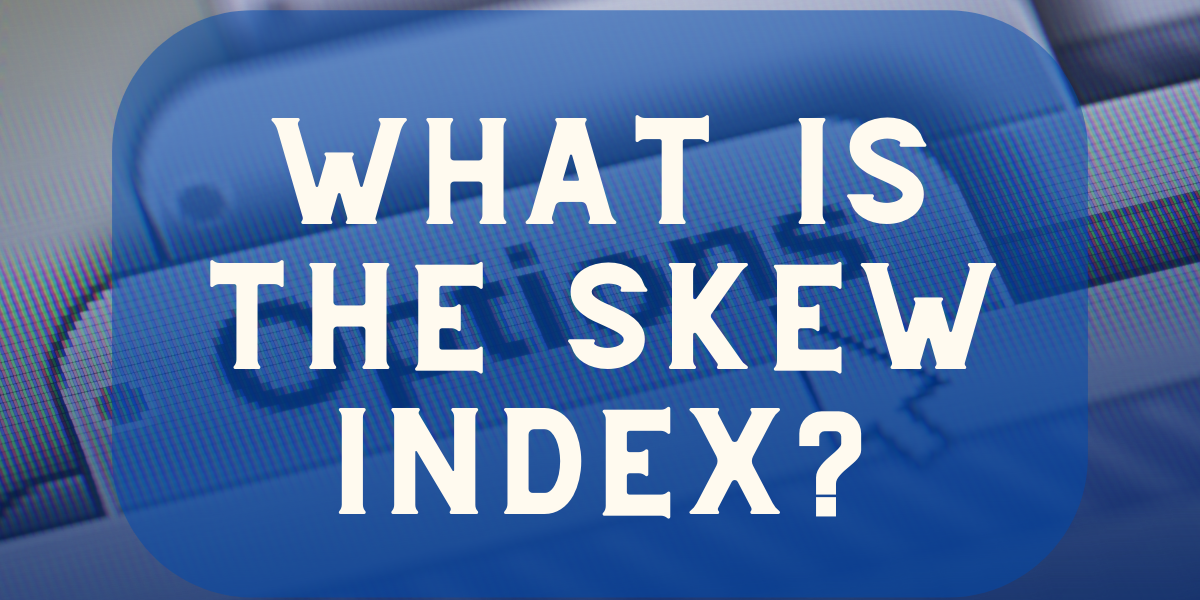The Skew Index, also known as the SKEW, is an options-based indicator that measures the perceived tail risk or probability of extreme negative market moves in the stock market. It is calculated and published by the Chicago Board Options Exchange (CBOE).
The Skew Index is derived from the prices of options contracts on the S&P 500 index. Specifically, it focuses on out-of-the-money put options with strike prices lower than the current market price of the underlying index. These put options are typically used as protection against downside risk.
A high Skew Index reading, typically above 100, suggests that investors are willing to pay a premium for out-of-the-money put options, indicating an increased expectation of potential market declines. On the other hand, a low Skew Index reading, typically below 100, suggests a lower perceived likelihood of extreme downward moves in the market. The Skew Index is often seen as a measure of market sentiment and can be used by traders and investors as an additional data point in assessing market risk.
What Does Skew Refer To?
When traders refer to skew, they generally discuss the shape of the distribution of implied volatility.
Implied volatility measures the market’s expectation of an underlying asset’s future price fluctuations or volatility. It is derived from the prices of options contracts on that asset. Options are financial derivatives that give the holder the right, but not the obligation, to buy or sell the underlying asset at a specific price (strike price) within a certain timeframe.
Implied volatility reflects the market’s consensus on the potential magnitude of future price movements of the underlying asset. Higher implied volatility indicates a greater expected range of price swings, while lower implied volatility suggests a lower expected range. Implied volatility is an essential concept in options trading because it affects the price or premium of options contracts. Elevated levels of implied volatility show that options premiums tend to be more expensive, reflecting the increased potential for more significant price movements. Conversely, when implied volatility is low, options premiums tend to be cheaper, reflecting reduced expected price fluctuations.
Traders and investors use implied volatility to assess the market’s risk and uncertainty perception. It can help decide on strategies, such as determining whether options are overpriced or underpriced relative to the market’s expectation of future volatility.
“Skew” typically refers to the asymmetry or lack of symmetry in data distribution or prices. In the context of implied volatility, skewness is a measure of the asymmetry of a probability distribution.
Skewness measures the degree and direction of skew in the distribution of a dataset. It helps to understand whether the distribution is more positively skewed (skewed to the right) or negatively skewed (skewed to the left) compared to a symmetric distribution.
Option skewness refers to the asymmetry in implied volatility levels for different strike prices. It indicates the market’s expectation of potential asymmetric moves in the underlying asset’s price.
How Is Implied Volatility Used in Options Pricing?
Implied volatility plays a crucial role in options pricing. It is one of the primary inputs used in mathematical models, such as the Black-Scholes model, to determine the fair value or price of options contracts.
Mathematical models, such as the Black-Scholes model or its variations, provide a theoretical framework for pricing options. These models consider several factors, including the underlying asset’s current price, strike price, time to expiration, risk-free interest rate, and volatility.
Implied volatility is an essential input in options pricing models. Unlike historical volatility, which measures past price fluctuations, implied volatility represents the market’s expectation of future volatility. Traders and investors use options prices and other variables to calculate the implied volatility.
Options pricing models, such as the Black-Scholes model, use implied volatility to estimate the fair value of options contracts. The model calculates the option’s theoretical price by inputting the current market price of the underlying asset, strike price, time to expiration, risk-free interest rate, and implied volatility into the pricing formula.
The calculated fair value from the pricing model represents the options contract’s theoretical price or fair premium. However, options prices may deviate from this fair value due to supply and demand dynamics, market conditions, and investor sentiment. Implied volatility helps account for these deviations and influences the actual options premiums traded in the market.
Implied volatility also affects options strategies. When implied volatility is high, options premiums tend to be more expensive, making strategies like buying options potentially costlier. Conversely, when implied volatility is low, options premiums are usually cheaper, making strategies like selling options potentially less rewarding.
How Does Skew Change Implied Volatility?
Skew refers to the asymmetry in the implied volatility (IV) of options with different strike prices but the same expiration date. It represents the market’s perception of the probability of extreme price movements in the underlying asset.
When the IV skew is positive, it indicates that the IV of out-of-the-money put options is higher than that of out-of-the-money call options. This scenario suggests that market participants are more concerned about potential downside risks or are willing to pay a higher premium for downside protection.
Conversely, when the IV skew is negative, the IV of out-of-the-money call options is higher than that of out-of-the-money put options. This situation indicates that market participants are more concerned about potential upside risks or are willing to pay a higher premium for upside potential.
Changes in skew can affect implied volatility. Suppose the skew becomes more positive (i.e., the IV of out-of-the-money put options increases relative to call options). In that case, it usually implies increased perceived downside risk in the market, which can lead to a rise in overall implied volatility.
On the other hand, if the skew becomes more negative (i.e., the IV of out-of-the-money call options increases relative to put options), it typically suggests increased perceived upside risk, which can also increase overall implied volatility.
How is Skew Used in Options Trading?
Skew is an essential concept in options trading and is often utilized by traders to inform their strategies and decision-making.
Skew can provide insights into market sentiment and expectations. A positive skew, where put options have higher implied volatility, might suggest a bearish or cautious outlook on the underlying asset. Conversely, a negative skew, with higher implied volatility in call options, might indicate a bullish or optimistic sentiment. Traders can use skew as a contrarian indicator to assess potential market directions.
Skew can impact the prices of options with different strike prices but the same expiration date. Traders can identify opportunities in volatility spreads by capitalizing on the differences in skew. For example, if the skew is more positive, a trader could consider buying out-of-the-money puts and selling out-of-the-money calls to take advantage of the higher premiums in puts.
Skew can also be used for hedging purposes. A portfolio manager or trader may adjust their hedge positions based on the skew. If the skew is positively sloped, indicating higher implied volatility in puts, a trader might consider buying put options to hedge against potential downside risks in the portfolio.
Skew can affect the pricing of options spreads, such as vertical spreads (e.g., bull call spreads bear put spreads). Traders may look for opportunities where the skew allows for favorable risk-reward scenarios in these spreads. For instance, a trader may prefer to execute a bear put spread (buying a put option with a lower strike price and selling a put option with a higher strike price) when the skew is positively sloped.
A call spread or put spread is a vertical spread. A vertical spread is an options trading strategy that involves buying and selling options of the same underlying asset with the same expiration date but different strike prices. This strategy is called a “vertical” spread because the options are stacked vertically on an options chain.
How is the Skew Index Calculated?
The skew index measures the skewness, or asymmetry, in option implied volatility (IV). It quantifies the difference between the implied volatility of out-of-the-money put options and out-of-the-money call options with the same expiration date. Calculating the skew index involves selecting a range of out-of-the-money put options and out-of-the-money call options for the underlying asset. These options should have the same expiration date but different strike prices.
It is created by calculating the implied volatility for each option. Implied volatility is the market’s expected volatility of the underlying asset derived from the option’s price. The average implied volatility of the out-of-the-money put options, and the average implied volatility of the out-of-the-money call options are calculated. The absolute difference between the average implied volatility of the put options and the average implied volatility of the call options. This absolute difference represents the skew index.
Typically, the skew index is presented as a percentage or a ratio. A positive skew index indicates that the implied volatility of put options is higher than that of call options, suggesting a more significant concern for downside risk. Conversely, a negative skew index suggests higher implied volatility in call options, indicating a greater concern for upside risk.
The Bottom Line
The Skew index is an index that describes the implied volatility skew. It can be used to price options or determine market sentiment. Generally, out-of-the-money options skew relative to the at-the-money options listed in an options chain. Understanding the impact of a skew on options’ values is helpful before you begin to trade options.


 Tags:
Tags:










